#David Michelinie Story
Explore tagged Tumblr posts
Text
AMAZING SPIDER-MAN #317 (1989) Todd McFarlane Cover & Pencils, David Michelinie Story, 4th Appearance of Venom (Eddie Brock) Versus Spider-Man
#AMAZINGSPIDERMAN #317 (1989) #ToddMcFarlane Cover & Pencils, #DavidMichelinie Story, 4th Appearance of #Venom (#EddieBrock) Versus #SpiderMan "The Sand and the Fury" After hearing that Venom has escaped from the Vault, Peter Parker is trying to act naturally around his Aunt May, reminding himself that Eddie Brock doesn't know where he is currently living. https://www.rarecomicbooks.fashionablewebs.com/SpiderMan%202.html#316 @rarecomicbooks Website Link In Bio Page If Applicable. SAVE ON SHIPPING COST - NOW AVAILABLE FOR LOCAL PICK UP IN DELTONA, FLORIDA #RareComicBooks #KeyComicBooks #MCU #MarvelComics #MarvelUniverse #KeyComic #ComicBooks

#AMAZING SPIDER-MAN#317 (1989) Todd McFarlane Cover & Pencils#David Michelinie Story#4th Appearance of Venom (Eddie Brock) Versus Spider-Man#Rare Comic Books#Key Comic Books#DC Comics#DCU#DC#Marvel Comics#MCU#Marvel#Marvel Universe#DC Universe#Dynamite Entertainment#Dark Horse Comic Books#Boom#IDW Publishing#Image Comics#Now Comics#Key Comics#Rare Comics#Vintage Comics
0 notes
Note
Hi! Had a kinda weird question, but is it ever mentioned how Matt paid for his education or any student loans?
Hi! This has been touched on a few times, yes. One good source of information is Daredevil volume 3 #12, in which Matt tells a story from his early days rooming with Foggy at Columbia.
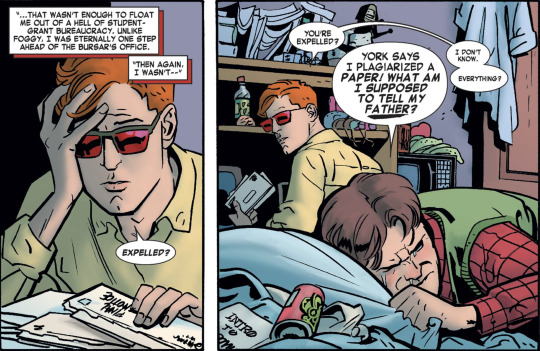
Matt: "[Being the teacher's pet] wasn't enough to float me out of a hell of student-grant bureaucracy. Unlike Foggy, I was eternally one step ahead of the bursar's office." Daredevil vol. 3 #12 by Mark Waid, Chris Samnee, Javier Rodriguez, and Joe Caramagna
This story takes place in law school and doesn't mention Matt's undergrad experience, but we learn that he was receiving financial aid (which seems believable for a high-achieving disabled student from a single-parent, low-income household; the Battlin' Jack Murdock mini-series also mentions that Matt was on a scholarship, implied to be tied to his disabled status), but was still struggling to pay (also unsurprising; Jack was still alive at this point, but it's hard to say how much money he was making). By the end of the story, Matt reveals that Foggy's well-to-do family stepped in at a certain point and helped keep him afloat until graduation (also unsurprising; Foggy's parents also financed the first Nelson & Murdock office).
Another thing to keep in mind about Matt's college experience is that the continuity changed in the early 80s. He wasn't always a Columbia grad; originally, he and Foggy attended the vaguely-named State College in upstate New York, and one of the reasons Matt picked that school was because it was affordable.
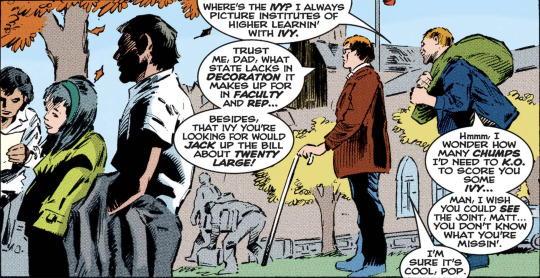
Daredevil vol. 1 #-1 by Joe Kelly, Gene Colan, Christie Scheele, Matt Ryan, and Richard Starkings
At this point, the only concrete thing we know about Matt's financial situation is that the money was coming from his father. The main reason Jack kept boxing past his prime, and the main reason he settled for signing on with the corrupt manager who eventually murdered him, was to afford Matt's college education.
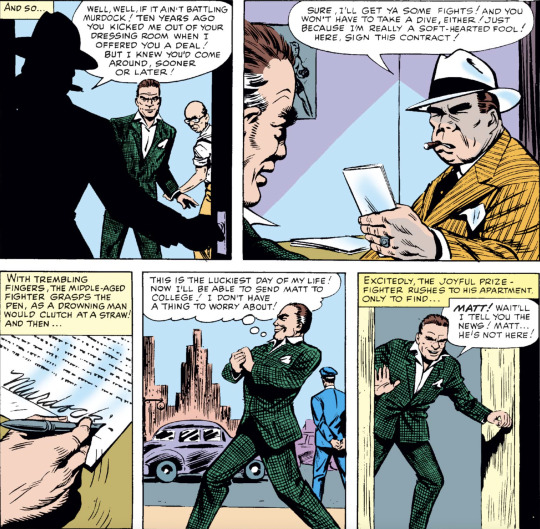
Daredevil vol. 1 #1 by Stan Lee, Bill Everett, and Sam Rosen
With the shift to a much more prestigious and expensive alma mater, with the cost of college having skyrocketed since 1964, and with the sliding timescale to take into account, it has definitely become harder to believe that Jack's boxing earnings would have been enough to pay for more than a semester-or-two. It wouldn't surprise me at all if some future retelling of Matt's origin at least put him in a work study program of some kind to make some extra cash.
As far as loans are concerned, I think a lot of people tend to forget that Nelson & Murdock were/are a very well-known and successful law firm. They've had their low points, sure, but there are plenty of key periods in their careers when they were making a ton of money. The Bendis/Maleev run (in which Matt is a high-profile public figure and goes to court wearing $2,000 suits) is an easy example, but we can look much earlier than that too. Matt is referred to as "one of the finest trial lawyers in the nation" as early as Daredevil volume 1 #20, and check out his swanky, tricked-out Sutton Place brownstone:
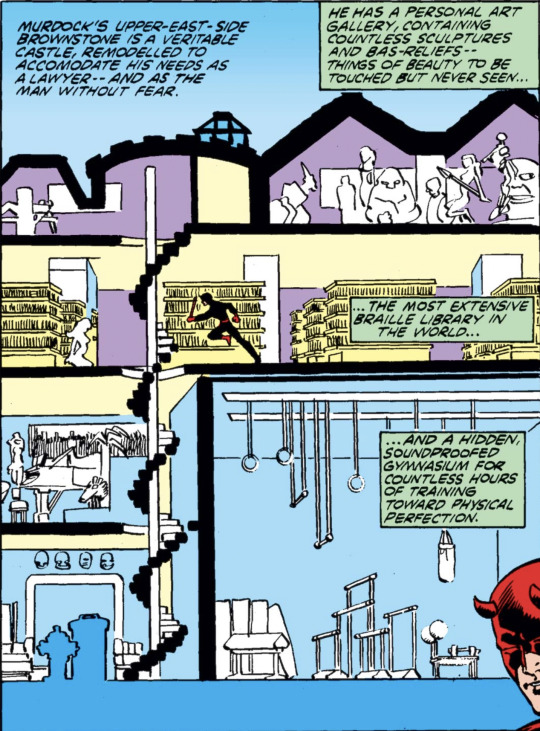
Daredevil vol. 1 #167 by David Michelinie, Frank Miller, Klaus Janson, Glynis Wein, and Joe Rosen
Given this, I tend to think that Matt hasn't had too much trouble paying off his loans.
Thanks for the great question!
#Daredevil#Matt Murdock#Jack Murdock#Foggy Nelson#Asks#Adventures in Continuity#ID in alt text#I just answered a question about money on my Iron Fist blog too. I love when that happens.
111 notes
·
View notes
Text

Action Comics #702 (August 1994)
Bloodsport (not the black one, the anti-black one) returns, which means this is gonna be another distressingly violent issue, but hey, at least we get to see Superman hit a Nazi! Right off the bat, we start with Bloodsport mowing down a nice black family because he wants to, as he puts it, "Keep Metropolis Clean." After the "Fall of Metropolis" storyline, the place is pretty messy, so I guess what he actually wants to do is Make It Clean Again, but I digress.
Meanwhile, Ron Troupe, who helped get rid of Bloodsport the last time he popped up, is working on an article in Lois Lane's borrowed laptop, which is apparently the only working computer in Metropolis right now. When they hear about Bloodsport shooting people up on a bridge, Lois and Ron rush there and arrive right in time to watch Superman get owned by pink goo. Racist pink goo.

(New writer David Michelinie sure loves covering guys in goo, huh?)
Bloodsport recognizes Ron (so he can tell black people apart), who once again has a chance to shoot him but can't bring himself to do it. Bloodsport is like "thanks, now I'll kill you anyway" and shoots at Ron but ends up killing a police officer instead. She looked Latina, though, so I guess that's still a win for him.
By the time Superman has freed himself from The Nazi Goo™, Bloodsport has left for "the largest African-American neighborhood in Metropolis," and not precisely to experience the rich culture and cuisine. Once Superman gets there, Bloodsport teleports a bunch of automated guns all around him, which don't look terribly intimidating to someone with bulletproof skin... until Bloodsport points them outwards, targeting random people in the neighborhood to keep Supes distracted while he goes off to do more hate crimes. I regret to inform you that this makes this racist asshole smarter than 90% of criminals Superman has fought.

While Superman deals with that, Ron, feeling guilty because that cop lady died due to his inability shoot guns, decides to fight Bloodsport through something he's actually good at: journalism. And also by logging into Lois' notebook without permission, but I'm pretty sure she'd understand (you'd think she would have gotten stronger passwords after Lex Luthor hacked her, though). Ron uses his own reporting and the dirt Lois recently dug up on Luthor to find out that all those guns Bloodsport can teleport on demand are currently being stored at the LexCorp tower. Luckily, it's much easier to sneak in there since half the place got blown to shit.
The next time Bloodsport tries to teleport a gun to his hand, he gets something else: a handful of molten metal, courtesy of Ron. Turns out Ron can't pull a trigger, but he's perfectly capable of pulling the pin on a grenade.

Without his teleporting guns, Bloodsport is just a regular bigot in a silly costume. Superman doesn't even deign himself to punch this worthless scum with his whole hand, since a finger will do.

Later, Clark compliments Ron on his bravery, but Ron says the real hero is everyone who goes through their day not being a racist asshole. Pretty low bar, Ron, but a nice sentiment.
NEXT: Zero Hour! Finally!
Creator-Watch:
As mentioned, this is the first issue written by Roger Stern's replacement, David Michelinie, fresh off his long run in Spider-Man comics where, among other things, he co-created Venom, the character who still keeps him infrequently employed at Marvel. This is a bit more violent and darker than I like my Superman comics to be (not surprising from the guy who introduced Iron Man's alcoholism and killed Aquaman's Aquababy) -- I'm not sure I like Clark smiling at the end when so many people died in the issue, including a little girl. At least he didn't wink this time!
But, other than that, I think this is a solid done-in-one story and I appreciate having Ron actually contribute to the plot in a meaningful way. Michelinie clearly did his homework in regards to the continuity and seems to have a good handle on the characters, particularly Lois and Clark. Their interaction in this issue is kinda hokey, but come on, it's Lois and Clark. They're allowed to be hokey.

However, I do remember having one serious complaint about Michelinie's run the first time I read it: an almost complete lack of Bibbo, which is unforgivable. We'll see how accurate that impression is.
Plotline-Watch:
Bloodsport says he survived the explosion in his last appearance because the circuitry in his weapon teleporter got "jangled" and teleported him away. Wait, so he suffered a teleporter malfunction in a comic and didn't become fused with his guns or something? Missed opportunity, if you ask me. At the very least he could have gained the ability to teleport at will, like a racist Nightcrawler. Maybe he could have inexplicably gained a German accent too.
Jimmy Olsen, who's apparently been looking for Lucy Lane since he ditched her with some wannabe rocker girls during the Massacre storyline (that had to be days ago, right?), finally finds her with those same girls, but it's okay because they're friends now. Lucy tells tells Jimmy that the Riot Grrrls invited her to that charity concert for rebuilding Metropolis we've been hearing about lately, the mere mention of which seems to offend Jimmy. Don Sparrow says: "I want to believe Jimmy’s 'whatchoo talkin' bout Willis' expression is due to his shared (with me) hatred of Jeb Friedman, the concern organizer." That, or he remembered that the concert headliner, his old friend Babe, owes him $5.

I've been reading several DC comics published in August 1994 and this is one of the few that didn't include any teasers for Zero Hour whatsoever (stuff like the future city in Green Lantern #54 or the dinosaurs in the latest issues of Guy Gardner: Warrior). At the time, some might have thought that having a full-on Nazi running around in the present could count as an anachronism but, uh, I think we've established by now that that's sadly not the case...
Plug-Watch:
On the subject of Superman punching Nazis, I fully recommend our old pal Patrick Ryall's "Superman vs. Bigots" column at The Avocado, where he goes over instances of Superman Family characters facing bigots across the ages, from the time Supes arrested Hitler in the '40s to the "Perry White vs. the Ku Klux Klan" issue from this era (which we haven't covered yet, so spoilers). Good stuff!
Now a self-plug: as mentioned in our post for the time-displaced Action #642, I've been putting together a sort of Superman '86 to '99 reading guide at my fav'rit current social media site (sorry, BlueSky), League of Comic Geeks, where I'm writing a short blurb about every issue from this era mentioning what's special, noteworthy, or weird/funny about it. At first I was just copying a paragraph or two from our old posts and throwing in a "read more" link, hoping to drive more readers to the newsletter, but I've started rewriting them to be more like something you'd see in an episode guide or a book about the '86-'99 period... which is an intriguing idea. Anyway, here's that reading guide link again, because this paragraph doesn't have enough clickable words in it already: https://leagueofcomicgeeks.com/profile/mrmxy/lists/58097/superman-86-to-99-checklist-wip
Shouts Outs-Watch:
Nazi-punching shout outs to our supporters, Aaron, Chris “Ace” Hendrix, britneyspearsatemyshorts, Patrick D. Ryall, Bheki Latha, Mark Syp, Ryan Bush, Raphael Fischer, Kit, Sam, Bol, Dave Shevlin, and Dave Blosser! Join them (and get extra non-continuity articles; we've got some cartoon-related ones lined up) via Patreon or our newsletter's "pay what you want" mode!
To see more of Don's take on this issue, including his thoughts on Jimmy's physique, keep reading!
Art-Watch (by @donsparrow):
We start with the cover, and it keeps the tradition of other Bloodsport covers where Bloodsport is firing a ridiculously high-calibre weapon. I know the cover text (which generally I dislike) is ironic in this context, but it still bugs me slightly—Bloodsport’s views are so poisonous, even as a villain I hate seeing them represented. But buckle up, because there’s a whoooooole lot of that in this issue.
Lucky for me I’m mostly here to focus on the art, and it’s good throughout, as upsetting and violent as some of the visuals are. The doomed, completely innocent family who are mowed down by gunfire on page 3 are very well drawn—and coloured—I love rim-lighting, and it’s rarely rendered in orange.

An odd thing happens on page 5, which you sometimes see—artists get so used to drawing everyone with superheroic proportions that even civilians get He-Man action figure physiques—this happens with Jimmy Olsen in that first panel (yes, another Superman song reference on a Jimmy Olsen t-shirt, this time it’s Crash Test Dummies being given a shout-out) looking pretty ‘roided out complete with obliques visible through his shirt. Not to say that I don’t think Jimmy’s in good shape, but typically he’s a bit more average in build, or so it seems in this suggestive pin-up by Jerry Ordway in 1988…

[Max: You have no idea the amount of research Don did to find that pin-up, which both of us remembered but couldn't place (it turned out to be in the incredible Modern Masters: Jerry Ordway book by TwoMorrows), but it was 100% worth the effort.]
Moving on, the upside down takeoff on page 13 is well done. Jackson Guice’s Superman always seems to have slightly longer hair than how the other artists draw him, but it’s a consistent thing, so I can’t complain too much. There’s an unfortunately Michael Jackson-looking Superman grimace on page 18 (shamone), but by the end of the story, Superman’s extremely ticked face is a great panel.
SPEEDING BULLETS:
The Daily Planet offices are, apparently, very near Boring Plaza, named after longtime Superman great, Wayne Boring.

GODWATCH: Dig the beat cop, Marcy, characterizing Superman as an answer to prayer on page 8. As things go wrong in other places in the book, both Ron Troupe and Superman invoke the almighty in frustration or despair. Lastly, as Clark and Ron bond in their agreement that racism is gross and wrong, and share an amen.

Perhaps unsurprisingly, Bloodsport does not support the then-current Democratic President, Bill Clinton.
Same as the last time this Alexander Trent version of Bloodsport popped up, I find this an extremely troubling issue. I get that Bloodsport is a villain, and a dastardly one at that. But even so, I hate some of the words and views he’s sharing—words I don’t even want to type to repeat here—appearing in a Superman comic at all. With characters this heinous, we almost need an editorial box disclaiming Trent’s statements, as they go unchallenged in the narrative as the character monologues to himself. Similar to the last issue with Bloodsport, there’s an awful lot of carnage and innocent death for a comics code book, and it’s something I think the better Superman stories steer away from. It’s hard not to be bothered by the juxtaposition of a black family being gunned down discriminately against Lois and Clark comfortably flirting.
Kudos to Ron for figuring out where Bloodsport’s weapons cache was, but, like in the last appearance of this Bloodsport, I can’t help but wonder why Superman doesn’t try to ionize the air around Bloodsport using his heat vision, since it was so effective the first time he faced this kind of teleporter tactic. A single line of dialogue could have hand-waved it away, but it seems like a missed opportunity. [Max: True. I would have even taken a "Drat, can't do that since I already did it in another issue! Gotta mix it up!"]
Some small irony that it was a clone war that reduced Metropolis to rubble in this issue, in the first issue from new Action Comics writer David Michelinie, who slinked away after kicking off the wildly controversial Clone Saga over in Spider-Man before joining DC Comics.
Any serviceman’s death in the line of duty is a tragedy, but this Carroll O���Connor looking sergeant must have been pretty close to his pension as it was, no? [Max: I think Bloodsport spared him, though... probably because he loves Archie Bunker so much.]

Missed an issue? Looking for an old storyline? Check out our new chronological issue index!
#superman#david michelinie#jackson guice#denis rodier#bloodsport#ron troupe#lucy lane#riot grrrls#nazi goo#sgt. archie bunker
29 notes
·
View notes
Text
alright, as promised, here is my personal venom reading guide as of right now, october 2024. disclaimer that this is not in any way intended to be definitive or universal and i am not an authority, i've just read a bunch of venom comics in the past five or so years and have strong feelings on the matter. there's some early stuff i would consider just objectively important for anyone who wants to read and understand venom, but there's also a lot of stuff that's on here because i personally like it (or not on here because i don't). it's highly subjective and informed by my personal opinions and biases. this is also specifically a guide to (primarily) eddie brock venom comics so if you're more interested in other hosts this will not be of much use to you. i have not read every venom comic in existence (there are a lot of them) and either way this is not intended to be an exhaustive list of The Only Comics You Should Read but if you're looking to start exploring the comics i think these are a pretty good place to start if you have remotely the same sensibilities as i do regarding these characters (which to be quite honest if you're getting your comic book recommendations from tumblr dot com you probably do). long disclaimer sorry but comics are SUCH a big and kind of scary topic. anyway the list is under the cut. starred titles are ones i consider particularly high priority if you're skipping around, either because they're plot-critical or because i think they're especially good. have fun
The alien costume arc — If you're able to read a collected edition you'll probably have an easier time than if you manually jump between comics, but I've included the full list anyway. This is a stupid way to publish a story. Comics are stupid. Unfortunately this one is also essential.
Setup — Mostly regular Spider-Man stuff with minor symbiote subplot; skippable or skimmable for symbiote highlights if desired. I would suggest skimming rather than skipping, since seeing how this arc actually played out in the comics is crucial to understanding the ways in which adaptations have warped people's perceptions of the Venom symbiote and of this storyline, which I personally think is a key part of learning to understand the symbiote as a character—there are some misconceptions you've probably picked up through cultural osmosis that you'll need to unlearn if you want to get to the heart of the character, and this is the place to start.
Marvel Super Heroes Secret Wars #8
The Amazing Spider-Man #252
Marvel Team-Up #141
The Spectacular Spider-Man #90
The Amazing Spider-Man #253
The Spectacular Spider-Man #91-#92
The Amazing Spider-Man #254
Marvel Team-Up #142-#143
The Amazing Spider-Man #255
Marvel Team-Up Annual #7
Marvel Team-Up #144
The Spectacular Spider-Man #93-#95
Marvel Team-Up #145
★ The Amazing Spider-Man #256-#258 — Even if you decide to skip the rest of the setup, you should read #258.
Marvel Team-Up #146
The Spectacular Spider-Man Annual #4
The Amazing Spider-Man #259
The Spectacular Spider-Man #96-#97
Marvel Team-Up #147-#148
The Amazing Spider-Man Annual #18
The Amazing Spider-Man #260-#261
The Spectacular Spider-Man #98
Marvel Team-Up #149
The Amazing Spider-Man #262
The Spectacular Spider-Man #99
Marvel Team-Up #150
The Amazing Spider-Man #263
The Spectacular Spider-Man #100
Climax — Absolutely not skippable! You will never understand the core of Venom without reading the end of the alien costume arc.
★ Web of Spider-Man #1
Later takes on the alien costume arc:
★ The Amazing Spider-Man (2018) Annual #1 by Saladin Ahmed — MANDATORY. Essential reading for symbiote sympathizers. I have this comic on display on a shelf above my bed.
Deadpool: Back in Black (2016) by Cullen Bunn (5 issues)
Venom's appearances as a villain in David Michelinie's issues of The Amazing Spider-Man — Important if you want to understand Venom's history and motivations. Also fun!
★ The Amazing Spider-Man #300 — Venom’s first appearance.
The Amazing Spider-Man #315-#317
The Amazing Spider-Man #332-#333
★ The Amazing Spider-Man #344-#347
★ The Amazing Spider-Man #361-363 — Carnage’s first appearance.
The Amazing Spider-Man #374-#375
★ Venom: Lethal Protector (1993) by David Michelinie (6 issues) — Venom’s first solo comic and introduction as an antihero.
Venom: Separation Anxiety (1994) by Howard Mackie (4 issues)
★ Planet of the Symbiotes (1995) by David Michelinie (5 issues) — An important piece of the puzzle in terms of understanding the symbiote as a character.
Part 1: The Amazing Spider-Man Super Special #1
Part 2: Spider-Man Super Special #1
Part 3: Venom Super Special #1
Part 4: The Spectacular Spider-Man Super Special #1
Part 5: Web of Spider-Man Super Special #1
Venom: Carnage Unleashed (1995) by Larry Hama (4 issues)
★ Venom: The Hunger (1996) by Len Kaminski (4 issues) — My favorite Venom comic!
Venom (2016) by Mike Costa (22 issues) — Symbrock central. As noted below, #159 and #160 are part of Venom Inc. and should be read in combination with the other relevant comics.
The Amazing Spider-Man: Venom Inc. (2017) by Dan Slott and Mike Costa (6 issues) — Really fascinating as an examination of how different characters view symbiotes.
Part 1: Venom Inc. Alpha (2017)
Part 2: The Amazing Spider-Man (2015) #792
Part 3: Venom (2016) #159
Part 4: The Amazing Spider-Man (2015) #793
Part 5: Venom (2016) #160
Part 6: Venom Inc. Omega (2018)
★ Venom: First Host (2018) by Mike Costa (5 issues) — A story that is interested in the ways in which symbiotes are vulnerable to their hosts in a way a lot of Marvel comics simply aren't. Also once again Symbrock central. Costa is probably the #1 Symbrock warrior, even if Kaminski is my personal hero on that front.
★ Venom: Lethal Protector (2022) by David Michelinie (5 issues) — There are no words I could possibly say that would be sufficient to convey to you how ecstatic I was when this comic was announced.
Venom: Lethal Protector II (2023) by David Michelinie (5 issues)
Venom: Separation Anxiety (2024) by David Michelinie (5 issues)
Supplementary material:
Venomverse
Edge of Venomverse (2017) (5 issues)
Venomverse: War Stories (2017) (1 issue)
Venomverse (2017) by Cullen Bunn (5 issues)
★ Extreme Venomverse (2023) (5 issues) — Even if you read no other Venomverse comics, do yourself a favor and read the Black Cat story in Extreme Venomverse #2.
Death of the Venomverse (2023) by Cullen Bunn (5 issues)
Venomverse Reborn (2024) (4 issues) — Unfortunately colored by the bizarre nature of current Venom canon even more than Death of the Venomverse is, although neither are bad comics in and of themselves. If you want to avoid all of that entirely you can read from Edge of Venomverse through Extreme Venomverse and stop there. I don't really keep up with post-Cates Venom canon and every time I see anything about it it baffles me so deeply.
★ Superior Carnage (2013) Annual #1 by Cullen Bunn — I'm kind of obsessed with this comic. Please read it.
Hybrid (1996) by Evan Skolnick — Makes up the second half of each issue of the following comics. Definitely dated in some ways, but introduces some great symbiotes and a great host.
Venom: Along Came a Spider (1996) (4 issues)
Venom: The Hunted (1996) (4 issues)
Venom: Seed of Darkness (1997) by Len Kaminski (1 issue) — A oneshot about Eddie encountering a different mysterious shadowy alien being before he ever bonded with the symbiote, written by the author of The Hunger. Not essential reading but it's a fun little standalone sci-fi story with some nice Eddie characterization.
Phenethylamine by Leah Williams, in Marvel Comics Presents (2019) #5 — Not really a recommendation so much as... a public service announcement, I guess. Is this my favorite comic in the world? No, but it would feel negligent not to tell you it exists. There are better comics. There are comics with a better understanding of the characters. But this is the only one that's explicitly about Eddie having sex with the symbiote, so do with that what you will.
#talk tag#symbiotic talk tag#the extensive disclaimer is mostly bc i know there are people who know more about this than me and i know there are other lists out there#and i want to be so extremely clear that i don't consider this Objectively Correct. i can only advise you from my own biased perspective#i think trying to put together a fully objective reading guide would probably be a fool's errand anyway#all i can fully and earnestly promise you about these recommendations is that they're heartfelt
34 notes
·
View notes
Text
Effective immediately I am assigning the following required reading for any Marvel writer who wants to compose a story involving Eddie Brock:
- Venom: Seed of Darkness (one shot, from the Flashback series, by Kaminski)
- Anything Venom written by David Michelinie (or at least published 1988-1993)
- Maximum Carnage (yes, the WHOLE DAMN THING this is not optional)
It's not a long list!! But if you are going to write about Eddie before he was Venom! You better read AT LEAST these!
#this is about the bad dialogue Mister Orlando is writing in his venom infinity comic. sorry Steve.#I'm just really upset about it lol
26 notes
·
View notes
Text




Today in 1981, Marvel's Star Wars #55 introduced my favorite non-canon character (except in my heart), Plif the Hoojib. This story (by writer David Michelinie, penciler Walt Simonson and inker Tom Palmer) was also adapted into the book-and-record set "Planet of the Hoojibs." Plif played a main role in the comics going forward.
24 notes
·
View notes
Note
Hii after tld I am trying to read the comics but I don’t know where to start, can you recommend me anything pls:3
Thanks for asking! Here are the most symbrocky of the comics. There are other good Venom comics, but this is where I'd start to fill in everything the movie left out:
“The Hunger” 1996 -- that's where I got my Tumblr banner image from. The most symbrock of any of the comics, in my opinion, even without saying anything outright. It explores the bond between Eddie and Symby and has a uniquely dark, eerie tone without going overboard on the edgelordness. I bought the whole volume it's collected in just for that storyline.
Mike Costa run, starting at issue #5 (the first four issues feature Symby getting abused by its host to the point that it regresses and is unable to speak properly. Eddie only shows up in Issues #5). I'm still unclear on why Eddie asked Liz Allen out other than to no homo a run full of "my love," "my darling," and literally giving birth together...clearly, it did not work.
"First Host" -- the Mike Costa extra featuring the symbrock baby, Sleeper.
Marvel Presents #5 (2019) -- It's a collection of Marvel stories, one of which features Eddie and Symby getting intimate. I have mixed feelings about choices made in part of the comic, and the art is terrible, but the actual intimacy is great! Also, it's barely PG-13, it's all implied and more psychological than anything else and inspired me to write a fic, it was so validating.
For non-specifically symbrock content after the cut!
David Michelinie wrote some great general Venom stories I recommend checking out. Even without overt symbrock (which is just one aspect of the characters!), and the absence of Symby's voice, you feel like he gets the characters and his writing isn't all doom-and-gloom.
"Venom: Seed of Darkness" (Len Kaminski, who also has good content) -- Not symbrock; this takes place while Eddie is still a reporter, but it shows how and why he'd bond so closely with Symby even without their mutual hatred of Spider-Man. Everyone is afraid of the alien monster he's reporting on; he's fascinated and even sympathetic iir.
Carnage (2015) -- It's dark and spooky and while it features Eddie, he's bonded to a different symbiote and the symbiotes are not the focus of the story. I like it for the Lovecraftian elements and characterization of Eddie, who seems more like himself than in other recent comics--a bit of a himbo, trying to do the right thing, loves kids, and is generally respectful of women (bunch of female characters in this one).
I also like the Agent Venom comics, though Eddie only briefly appears and Symby is bonded with Flash Thompson, the soldier who lost his legs in the movie. Those are just generally solid action comics with some character development for Flash.
I do not personally recommend the other pre-Costa 2000s Venom comics, as they mostly feature Eddie and Symby hating each other to various extremes and being generally very OOC. This is the era when Venom got dark and edgy and weird in a bad way, with Eddie going off the rails and Symby having a variety of awful hosts. Some good stuff to cherry pick, like Symby still loving Eddie when it sees him in that Anti-Venom getup, but generally bad, bad, bad imo.
I'm only current as of the beginning of Donny Cates's run, as I didn't like where he was going with it and the Look How Dark and Edgy This Is of it all. He also was disrespectful to fans who shipped symbrock (despite it being canon in the Costa run) and tried to no homo it...by having them co-raise a son and having Symby tell Eddie "I love you." Whatever he intended, he clearly backed away from the symbrock so hard he bumped into himself. All that being said, he does explore what Eddie and Symby mean to each other and packs in some good grieving from Eddie when he loses Symby (....who is a dog at the beginning of the run...)
Still, I'm sure there's a lot to like in there even if his dismissal of fans and worship by dudebros has always left a bad taste in my mouth and I stopped reading relatively soon.
I'd avoid Venom: The Madness, too. Hate that one!
Something to be aware of is that both Eddie and the symbiote are very different in the comics than they are in the movie! It varies from writer to writer, but Symby isn't as vocal and sassy and Eddie is just a different character with certain constants that didn't make it into the movie much--a difficult childhood with a distant father, loves kids, uses big words, Catholic, bodybuilder, generally respectful of women (okay that might just be my opinion after reading a lot of comics and cherry-picking the series I like--do not read Venom: The Madness!), and wants to protect innocents, his defining trait.
#feel free to put more recs in the notes! these are my personal favorites#The Costa run were the last time the comics were joyful as far as I know#90s Venom was bonkers!!#I think people forgot that when they went into the first movie expecting something more Donny Cates-like#to be clear there's nothing wrong with darker comics but it was so jarring after Costa's bright goofy loving comics#plus all the drama alienating his symbrock-shipper fans#I'm not a huge Carnage fan—loved him in the movie though--but there's one amazing Carnage comic I would rec too#I wish I could find it! It's Carnage in an asylum talking to a doctor and driving her mad (?)#venom comics#lmk if anyone knows where that's from! It's one of those stand-alone specials#ask tag#lair posts
17 notes
·
View notes
Text
Venom: Marvel’s Iconic Alien Antihero (A Deep Dive into Marvel’s Iconic Alien Entity)

The Venom symbiote is one of Marvel Comics’ most famous and enduring creations. Known for its chilling appearance, complex personality, and profound impact on Marvel's universe, the symbiote has cemented its place in pop culture as both a villain and an antihero. Its journey spans decades, influencing countless storylines and characters.
Origins of the Venom Symbiote
The Venom symbiote made its first full appearance in The Amazing Spider-Man #300 (1988), written by David Michelinie and illustrated by Todd McFarlane. However, the symbiote itself was introduced earlier, in The Amazing Spider-Man #252 (1984), during the famous Secret Wars crossover event. In this storyline, Spider-Man acquires a black, living suit while on an alien planet. What initially seemed like a technological marvel was soon revealed to be a sentient alien organism.
The idea of the black suit originated from a fan, Randy Schueller, who submitted a design concept to Marvel in the early 1980s. The company purchased the idea for $220, transforming it into one of the most iconic designs in comic book history.
The symbiote comes from the planet Klyntar, where it was created as part of an alien species designed to bond with other beings to form symbiotic relationships. However, unlike its peaceful brethren, Venom developed a darker, more parasitic nature. It desired strong hosts and often corrupted them to feed on their emotions and strength.
The Bond Between Spider-Man and the Symbiote
When Spider-Man first wore the black suit, it enhanced his powers, including strength, speed, and agility, while providing unlimited webbing and a sleek, intimidating look. However, as Peter Parker discovered, the suit was alive and began influencing his behavior. The symbiote amplified his aggression and darker tendencies, creating a rift between the two. Realizing the danger, Peter rejected the symbiote, using the church bells’ soundwaves to separate it from his body—a moment that has been immortalized in both comics and film adaptations.
This rejection deeply scarred the symbiote, fostering a hatred for Spider-Man that would define much of its early stories. Seeking revenge and a new host, the symbiote found Eddie Brock, marking the beginning of Venom’s most famous partnership.
Eddie Brock: The First and Most Iconic Venom
Eddie Brock, a disgraced journalist, became the first human to fully bond with the Venom symbiote. United by their shared hatred for Spider-Man, they became the villainous Venom. Unlike Spider-Man, Eddie embraced the symbiote’s influence, granting him immense power and a grotesque appearance characterized by a hulking physique, sharp teeth, and an elongated tongue.
As Venom, Eddie posed a formidable threat to Spider-Man. The symbiote’s bond gave him knowledge of Peter Parker’s identity and powers, allowing Venom to bypass Spider-Man’s spider-sense and exploit his weaknesses. However, Venom’s complex morality distinguished him from other villains. Despite his animosity toward Spider-Man, Venom had a twisted sense of justice, often targeting those he deemed evil or corrupt.
Over time, Venom evolved from a villain to an antihero, protecting innocents while battling inner demons. This transition became a defining trait, making the character more relatable and layered.
The Symbiote’s Many Hosts
The Venom symbiote has bonded with numerous hosts, each bringing unique dynamics to its character. Some of the most significant hosts include:
Peter Parker/Spider-Man The symbiote’s first major host and its most famous rejection. The relationship between Spider-Man and the symbiote established its core themes of temptation and corruption.
Eddie Brock The quintessential Venom, Eddie’s partnership with the symbiote defined much of its character development. Together, they transitioned from villains to antiheroes, embodying themes of redemption and identity.
Mac Gargan (Scorpion) When Eddie temporarily separated from the symbiote, it bonded with Mac Gargan, transforming him into a more monstrous and violent version of Venom. As part of the Dark Avengers, Gargan’s tenure as Venom explored the symbiote’s darker nature.
Flash Thompson A surprising and beloved host, Flash Thompson bonded with the symbiote to become Agent Venom. As a government operative, Agent Venom represented the symbiote’s potential for heroism. This era explored themes of control and redemption, as Flash sought to use the symbiote’s power for good while resisting its darker impulses.
Dylan Brock Eddie Brock’s son, Dylan, inherited the symbiote in recent storylines, offering a fresh perspective on the Venom legacy. His bond with the symbiote explores themes of family, legacy, and responsibility.
Other Hosts The Venom symbiote has also briefly bonded with characters like Wolverine, Deadpool, and even the Hulk, showcasing its adaptability and the diverse ways it influences its hosts.
Abilities and Characteristics of the Venom Symbiote
The Venom symbiote grants its hosts a wide array of powers, many of which enhance or mimic Spider-Man’s abilities. Some of its most notable traits include:
Superhuman Strength and Durability The symbiote significantly enhances the physical attributes of its host, making them capable of feats of incredible strength and endurance.
Web-Slinging and Shape-Shifting Like Spider-Man’s web-shooters, the symbiote can produce organic webbing. It can also morph its appearance, forming weapons, shields, or camouflage.
Regenerative Healing The symbiote can heal its host from injuries, making them more resilient in battle.
Immunity to Spider-Sense A unique feature, the symbiote and its host cannot be detected by Spider-Man’s spider-sense, giving Venom a tactical advantage.
Emotional Influence The symbiote feeds on the emotions of its host, often amplifying their aggression and darker tendencies. This characteristic underscores its parasitic nature.
Independent Sentience While it bonds with hosts, the Venom symbiote retains its own consciousness and desires. This independence creates a dynamic relationship, often fraught with tension and conflict.
The Evolution of Venom in Comics
Venom’s evolution reflects the changing landscape of comic storytelling. Initially introduced as a villain, Venom quickly became an antihero, reflecting the rise of morally ambiguous characters in the late 1980s and 1990s. Stories like Venom: Lethal Protector (1993) marked the character’s transition from Spider-Man’s nemesis to a protagonist in his own right.
In the 2000s and 2010s, Venom’s mythology expanded significantly. Storylines like King in Black (2021) introduced Knull, the god of symbiotes, revealing the symbiote’s cosmic origins. This deepened Venom’s lore, connecting it to broader Marvel narratives.
Venom’s journey has also explored themes of identity, addiction, and redemption. Through its many hosts, the symbiote embodies the struggle between light and darkness, showcasing the potential for both corruption and heroism.
Venom Beyond Comics
Venom’s popularity extends far beyond the pages of comic books. The character has appeared in numerous animated series, video games, and films, each iteration contributing to its legacy.
Animated Series Venom has been a recurring character in Spider-Man’s animated adaptations, from the 1994 series to Ultimate Spider-Man. These appearances introduced the symbiote to new generations of fans.
Video Games Venom has featured in many Spider-Man video games, including Spider-Man: Web of Shadows and Marvel’s Spider-Man 2 (2023). These games highlight the symbiote’s versatility and its appeal as both a villain and a playable character.
Live-Action Films Venom made his cinematic debut in Spider-Man 3 (2007), portrayed by Topher Grace. While divisive, this portrayal introduced the symbiote to mainstream audiences. The character was later reimagined in Venom (2018) and Venom: Let There Be Carnage (2021), starring Tom Hardy. These films leaned into Venom’s antihero persona, blending humor and action to great success.
Merchandise and Cultural Impact Venom’s iconic design and versatility have made it a staple of Marvel merchandise, from action figures to apparel. The character’s blend of horror and heroism resonates with audiences, making Venom a cultural icon.
Themes and Symbolism
The Venom symbiote symbolizes the duality of human nature—the constant struggle between light and darkness. Its parasitic nature reflects themes of addiction and temptation, while its capacity for heroism showcases the potential for redemption. These themes make Venom a compelling character, capable of evolving with the times while remaining true to its core.
Conclusion
The Venom symbiote is more than just a villain or antihero; it’s a multifaceted character that embodies the complexity of human emotion and morality. From its origins as Spider-Man’s black suit to its transformation into a cosmic entity, the symbiote has
captivated fans for decades. Its ability to adapt to different hosts and narratives ensures its place as one of Marvel’s most enduring creations. As Venom’s story continues to unfold, its legacy as a symbol of power, struggle, and redemption remains as strong as ever.
#marvel characters#marvel comics#knull#mcu#spiderman#carnage symbiote#marvel symbiotes#god of symbiote#symbiote spider man#god of symbiotes#venom symbiote#venom king in black#venom
7 notes
·
View notes
Text
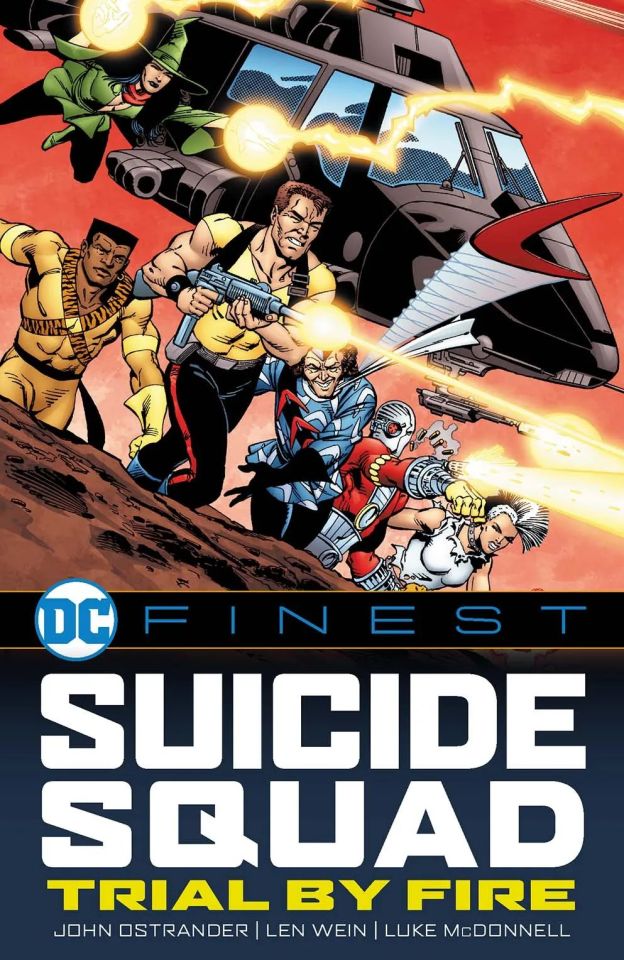
Spoilers for comics in January 2025!
You can see them in full at Adventures In Poor Taste.
It's mostly just reprints for that month, but here's the Flash solicit now that we know Marco will be in the upcoming Skartaris storyline. Strangely, no cover is provided.
THE FLASH #17 Written by SIMON SPURRIER Art by VASCO GEORGIEV Cover by MIKE DEL MUNDO Variant covers by DIKE RUAN and BALDEMAR RIVAS $3.99 US | 32 pages | Variant $4.99 US (card stock) ON SALE 1/22/25 As The Flash races to contain damage to Skartaris, forces both below and above ground make their move to grasp power. The Flash Family vacation leads the West clan to meet the one and only Warlord!
This next book is obviously a collection with tons of Digger, so fans of his might want to pick it up!
DC FINEST: SUICIDE SQUAD: TRIAL BY FIRE Written by JOHN OSTRANDER Art by LUKE McDONNELL, JOHN BYRNE, JOE BROZOWSKI, and more Cover by LUKE McDONNELL and KARL KESEL $39.99 US | 560 pages | 6 5/8″ x 10 3/16″ | Softcover | ISBN: 978-1-77950-075-9 ON SALE 3/11/25 Task Force X was created in World War II to neutralize metahuman and supernatural threats. Over time, the roster was updated to include incarcerated supervillains who could reduce their prison sentences if they went on dangerous assignments that were deemed suicide missions. Thus, Task Force X earned a new nickname: the Suicide Squad! This first collection of John Ostrander and Luke McDonnell’s classic run includes stories from Suicide Squad #1-10, Secret Origins #14, Detective Comics #582, The Fury of Firestorm #62-64, Firestorm: The Nuclear Man Annual #5, Legends #1-6, and Millennium #4.
This next trade should include a couple of stories with Rogues, since Kadabra appears in a couple of these stories, and some other Rogues appear a bit too.
LIMITED COLLECTORS’ EDITION #48 FACSIMILIE EDITION Written by E. NELSON BRIDWELL and JIM SHOOTER Art by CURT SWAN, ROSS ANDRU, NEAL ADAMS, CARMINE INFANTINO, GEORGE KLEIN, and DICK GIORDANO Cover by CARMINE INFANTINO, JOSÉ LUIS GARCÍA-LÓPEZ, and BOB OKSNER $14.99 US | 56 pages ON SALE 1/22/25 The greatest races of all time between Superman and the Flash are reproduced in this tabloid-size facsimile of the 1976 Limited Collectors’ Edition classic. In addition to tales of super-speed, this issue includes bonus features like a tour of Superman’s Fortress of Solitude drawn by Neal Adams and “How to Draw the Flash!” by Carmine Infantino. Test your knowledge with a Flash puzzle and be sure to buy a second copy to cut out the tabletop diorama on the back cover.
The next trade has a Bronze Age Eobard story in it (the one in which he gets salty about being called the Reverse Flash).
DC FINEST: TEAM-UPS: CHASE TO THE END OF TIME Written by MARTIN PASKO, DAVID MICHELINIE, LEN WEIN, and more Art by JOSÉ LUIS GARCÍA-LÓPEZ, MURPHY ANDERSON, CURT SWAN, and more Cover by JOSÉ LUIS GARCÍA-LÓPEZ and DAN ADKINS $39.99 US | 560 pages | 6 5/8″ x 10 3/16″ | Softcover | ISBN: 978-1-77950-082-7 ON SALE 3/18/25 The Man of Steel and the Flash! The Caped Crusader and Black Canary! See the World’s Finest duo of Superman and Batman join forces with other DC superheroes in DC Finest: Team-Ups: Chase to the End of Time, collecting some of the most exciting team-up stories from the Bronze Age of comics from May 1978 to October 1979. Featuring the works of some of the greatest artists and writers in comics, this volume contains stories from DC Comics Presents #1-14 and The Brave and the Bold #141-155.
#Captain Boomerang#Weather Wizard#the Flash#Professor Zoom#Reverse Flash#Superman#spoilers: comics#solicits
11 notes
·
View notes
Text
The Avengers celebrated their 200th issue with a double sized issue with cover date of October, 1980. The issue introduced Marcus Immortus and Sir Cecil of Clampett created by Jim Shooter, George Perez, Bob Layton,and David Michelinie. The issue had the controversial story line where Ms Marvel was manipulated into getting impregnated by her own son to give birth to him. ("The Child Is Father To...", Avengers 200#, Marvel Comic Event)
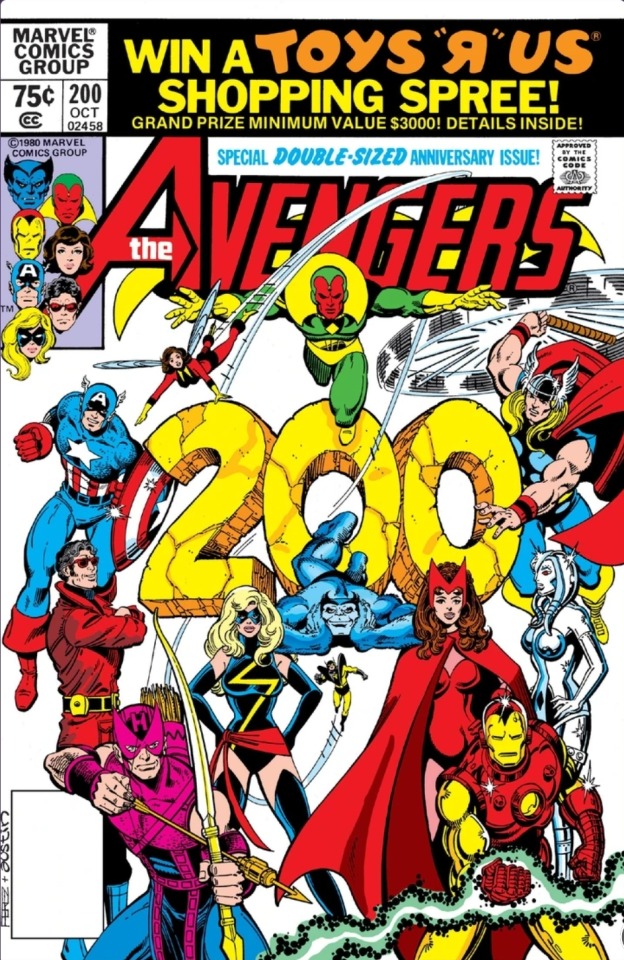
#nerds yearbook#real life event#first appearance#comic book#marvel#marvel comics#October#1980#jim shooter#george perez#bob layton#david michelinie#the avengers#marcus immortus#cecil of clampett#ms marvel#limbo#wonder man#captain america#steve rogers#iron man#tony stark#donald blake#beast#hawkeye#vision#scarlet witch#wasp#yellow jacket#jocasta
6 notes
·
View notes
Text
Recent Reads:
I haven’t done a round up of stuff I’ve picked up randomly for a while so let’s have one:-
Exit Stage Left: The Snagglepuss Chronicles: I tried this, on the back of the fact I do enjoy Mark Russell’s satire. After one issue I rapidly realised I simply don’t know enough about the Hanna-Barbera characters in this to care about the adaption going on. The premise is interesting, it’s just Not For Me.
Madame Xanadu 2008 #1-10: this is Matt Wagner with Amy Reeder on art. Reeder's art is ADORABLE and she has such fun drawing elaborate clothing all the way through this. I really enjoy Matt Wagner's ability to take old stories or concepts and breathe a modern comics approach into them, making them a lot more accessible. This is Wagner telling the backstory of Nimue Inwudu, stopping in with her at 5 points in her history (Camelot, the court of Kublai Khan, the French Revolution, Jack the Ripper London, and America WWII) and her interactions with a bunch of characters from the Magic side of DC (Merlin, Etrigan, Death of the Endless, the Phantom Stranger, Giovanni Zatara, and Jim Corrigan as the Spectre). Nimue has a MASSIVE beef with the Phantom Stranger. She does not like him at all, because he keeps turning up at some of the worst points in her life and won't help her try to evade terribly fated things. Come for the Amy Reeder art, stay for the story.
The Demon: Hell is Earth 2018: I enjoyed this. Because I don’t clean read Etrigan stuff in order I cannot remember if Etrigan is officially a Rhymer again as of Rebirth (he appears to be rhyming for fun and because he enjoys it, but isn’t bound to do so, but he’s also getting mocked by his demon uncle for using rhymes). In any case, Jason Blood and Etrigan get separated for hell-related reasons, and they’re running around with Madame Xanadu and Merlin to prevent Belial taking over Earth by invading from Hell. Good times. Lots of people die. Etrigan potentially ends up King of Hell at the end of this story.
Swamp Thing: I was going to make this its own post but heck let’s put everything in together.
Len Wein (Swamp Thing #1-13 1972): Wein's work is absolutely solid magical horror. He sets up an intriguing premise to build from and he can spin a good story. It's exactly the sort of amusing writing that keeps me coming back to, say, Warlord. Worthwhile to see the starting premise.
David Michelinie (Swamp Thing #14-18, 21-22 1972): Not as good at Wein, but definitely can tell a story. You can tell he spent time on House of Mystery given the episodic horror nature of his storytelling.
Gerry Conway (Swamp #19-20, 23-24 1972 plus Challengers of the Unknown #81-87 1977): Conway I think is the first writer who actually gets some of the specific horror you can imbue in this concept, especially around identity. I can see how his ideas could contribute to the later concepts Moore will introduce. I don't think his execution is fantastic but the hand regeneration? Yeah. Yeah that is playing with the ideas available.
Martin Pasko (Brave and the Bold #176 1955, Saga of the Swamp Thing #1-19 1982): Pasko is definitely processing things. Like, the man has an entire story that's just him responding to the Atlanta Child Murders of 1979-1981. He is very much a cynic about the innocence of childhood (or innocence in general, actually) and wants to explore the dark side of humanity.
The Phantom Stranger: these have been backups to the Martin Pasko Swamp Thing issues. Mostly I’ve found them pretty trite and a bit overly religious in places. Yes I know his entire concept is rooted in religious myth (as the Wandering Jew) but I mean more in a 'this tale has an Overt Christian Moral' way. The concept of the character is fascinating. The execution seems to be very across the shop.
Outsiders #1-33 2003: oh boy. Uh. Tomasi's fill using the original Batman & The Outsiders characters was a WELCOME reprieve to this. Okay, in terms of the main run: I tend to find Judd Winick a writer that either I'm fully enjoying or decidedly not to my taste. Outsiders falls into the 'not to my taste' category. I can see what Winick is going for in terms of 'let's make this Gritty! And Mature!' except for it's really not that gritty and his idea of making it mature is just having everyone hooking up a lot on panel, whether or not said hookup makes characterisation sense. And then he'll turn around every 10 issues or so and have some quite interestingly interrogative storytelling about Dick and Roy. (literally: you want issues #1, 11 and 21). I see what a bunch of the DickRoy shippers enjoy in this, but there's a lot of cantilevered cloud structures required to extract the Shippy Goodness out of the rest of this run.
9 notes
·
View notes
Text
Venom Lethal Protector #1 (1993) Red Foil cover Mark Bagley Cover, Mark Bagley Pencils, David Michelinie Story, 1st Venom Solo Series
#VenomLethalProtector #1 (1993) #MarkBagley Red Foil Cover, Mark Bagley Pencils, #DavidMichelinie Story, 1st #Venom Solo Series "Dark Soul Drifting" - Venom moves to San Fransisco to try out his new protection of innocents racket; Venom and Spidey save a group of homeless folk. https://www.rarecomicbooks.fashionablewebs.com/Venom%20Lethal%20Protector.html#1 @rarecomicbooks Website Link In Bio Page If Applicable. SAVE ON SHIPPING COST - NOW AVAILABLE FOR LOCAL PICK UP IN DELTONA, FLORIDA #RareComicBooks #KeyComicBooks #MCU #MarvelComics #MarvelUniverse #KeyComic #ComicBooks

#Venom Lethal Protector#1 (1993) Red Foil cover Mark Bagley Cover#Mark Bagley Pencils#David Michelinie Story#1st Venom Solo Series#Rare Comic Books#Key Comic Books#DC Comics#DCU#DC#Marvel Comics#MCU#Marvel#Marvel Universe#DC Universe#Dynamite Entertainment#Dark Horse Comic Books#Boom#IDW Publishing#Image Comics#Now Comics
0 notes
Photo


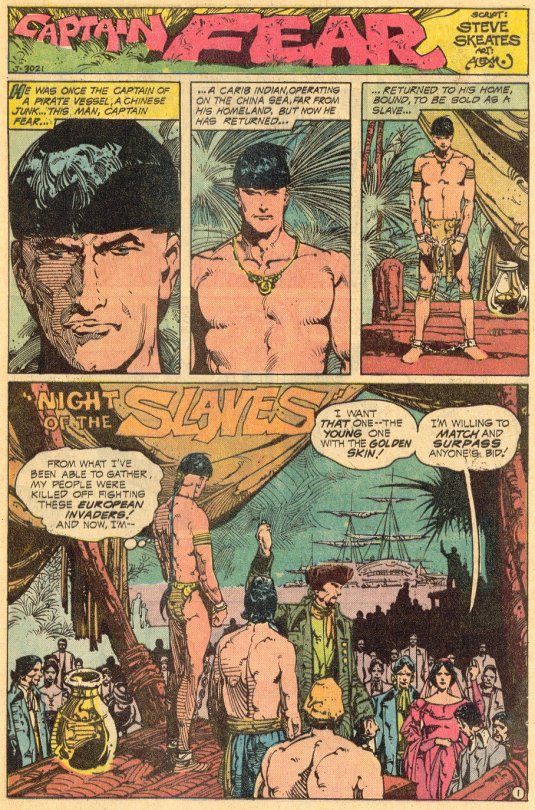
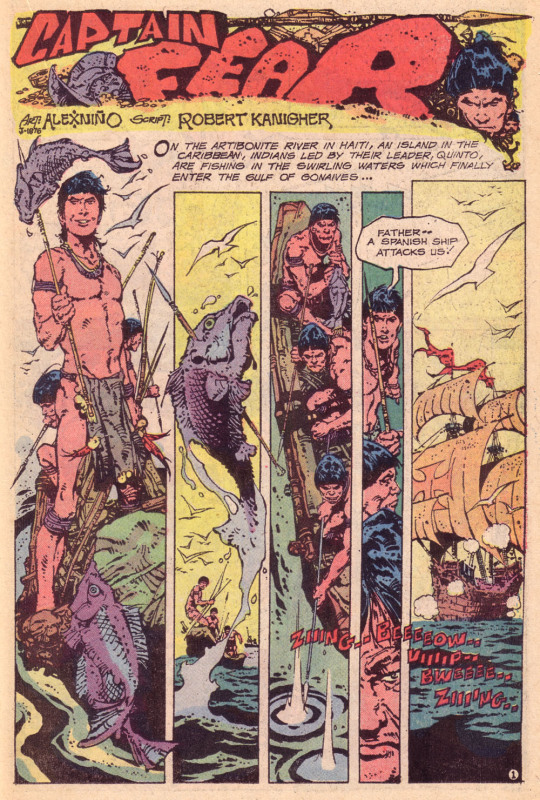


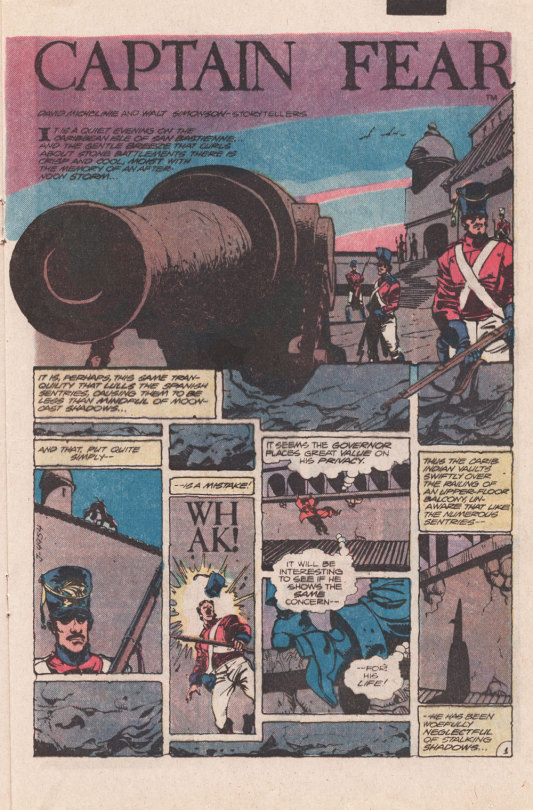

Title pages from DC Comics CAPTAIN FEAR backup stories. Art by Alex Nino and Walt Simonson.
Scripts by Steve Skeates, Robert Kanigher and David Michelinie.
84 notes
·
View notes
Text

LOOKING DOWN THE COLD, HARD STARE OF CALCULATED DESPOTISM AND HIS IRON WILL
PIC INFO: Resolution at 1280×1813 -- Spotlight on a killer close-up shot and/or panel of Marvel Universe sorcerer, mad scientist, time traveler, and supervillain, Doctor Victor Von Doom, a.k.a., Doctor Doom, from "Iron Man" Vol. 1 #150 ["KNIGHTMARE"[. September, 1981. Marvel Comics.
STORY/SCRIPT: David Michelinie & Bob Layton
PENCILER: John Romita Jr.
INKERS: Bob Layton
COLORISTS: Bob Sharen
LETTERERS: Joe Rosen
Source: www.pinterest.com/pin/25121710411520474.
#Dr. Doom#Doctor Doom#Marvel Villains#Supervillains#Comic Book Panels#Comics#Marvel Universe#DOOM!#Victor Von Doom#Doctor Victor Von Doom#Dr. Victor Von Doom#Knightmare#Comic Book Art#Comics Art#David Michelinie#Bob Layton#John Romita Jr.#80s Comics#Von Doom#DOOM#80s Marvel#1981#Iron Man Vol. 1 Knightmare#JRJR#Marvel#Fantastic Four Villains#Sci-fi Fri#Iron Man Vol. 1#Bob Sharen#Marvel Comics
2 notes
·
View notes
Text
BHOC: IRON MAN #116
This next issue of IRON MAN represented the beginning of one of the most storied runs in the title’s history, even though it was the second part to an adventure already in progress. And that’s because this issue heralded the arrival of a pair of creators who would leave their mark on the armored Avengers, David Michelinie and Bob Layton. They joined artist John Romita Jr who had debuted in the…

View On WordPress
37 notes
·
View notes
Note
would you be willing to recommend me some venom comic runs? i'm a comics guy generally but i've never read venom. recently watched the movie and it was baller.
Hey there friend! So, Venom is coming up on 35 years as of 2023 (wow!) so you have a lot of options. There's pretty much something for everyone out there, but given that you liked the movie, I can probably point you in the right direction...
If you can get your hands on trades (or even just use them as a guide for your favorite Digital Comics Avenue) that's gonna be your best bet. The Epic Collections (link to Wikipedia) are really comprehensive. The chart even has them in order! Handy!
If you don't want to be flipping between fifty different Spider-Man series, though, you can definitely start with some of the Venom-titled books! I've tried to pick ones that don't require a whole lot of backreading.
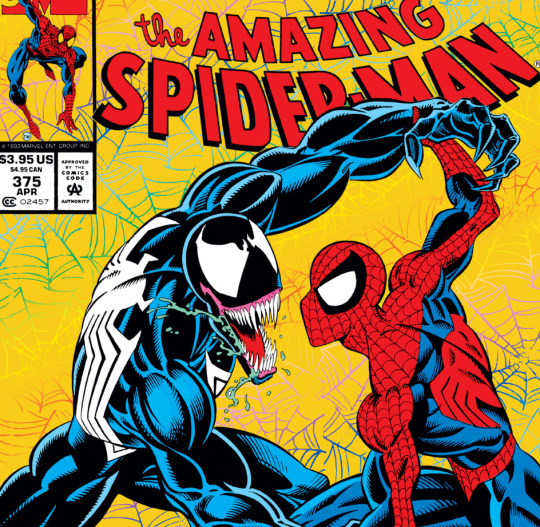
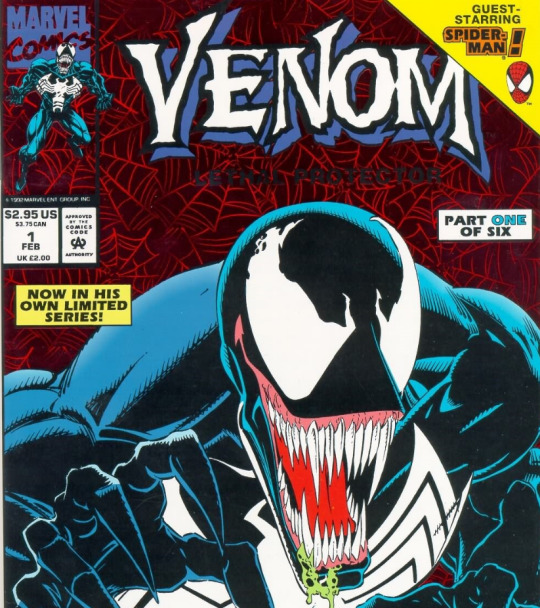
So, easy starting point is going to be Venom: Lethal Protector (1993) #1-6. I strongly recommend reading Amazing Spider-Man #373-375 first if you can, since #375 is the first appearance of Anne Weying. LP is to this day one of my favorite series, and it has some of the best Venom and Spider-Man moments. All are written by David Michelinie, and pencils are by Mark Bagley or Ron Lim.
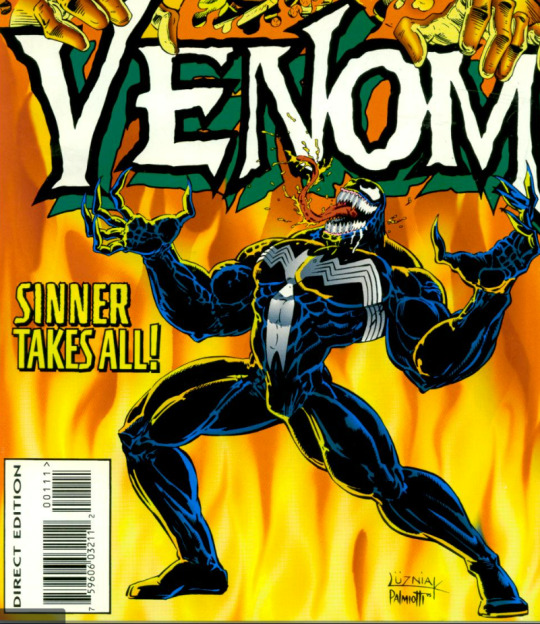

If you like Anne Weying, Venom: Sinner Takes All and Venom: Along Came a Spider are the two miniseries that feature her the most. Both are written by Larry Hama. The latter has art that is... kinda rough in my opinion, but if you can look past it, they're both neat. The other thing to keep in mind is that with ACAS is that it does take place in the middle of Spider-Man Clone Saga (well.. after Ben Reilly has taken up the mantle) so it's not as new reader friendly but it IS fun. I like when Anne whacks Ben.

Are these comics good? Eh... "Sinner" is probably the stronger story of the two, but when you like Anne, you can't be too picky about what you get, unfortunately!

I also absolutely have to recommend the Planet of the Symbiotes event, which immediately follows Venom: Separation Anxiety (one of my personal favorite series). I recommend "Separation" First and then just checking out a collection of the PotS event, like this one here (link to readcomicsonline). Otherwise you have to sort out which Super Specials to read and it's annoying and dumb. The nice thing about PotS is that it's an excellent story by Michelinie with.. hmm.. let's say inconsistent art, but it's very fun and even if you're a little lost by the Clone Saga stuff, don't worry about it!! You'll be fine.
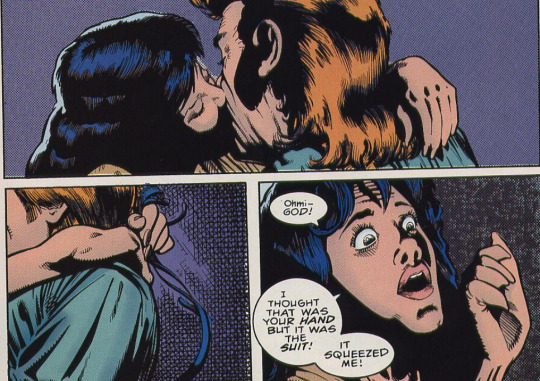

And finally, if you're looking for something a little more wacky, you can't go wrong with Venom: The Madness (W: Ann Nocenti, A: K. Jones) and Venom: Carnage Unleashed (W: Hama, A: Wildman, Nichols)! They are both very 90s off-the-wall insane and just like. Absolutely bonkers-nuts. The Madness also has the distinction of introducing Eddie (and Venom's!) first love interest since Anne. Mwah! 😘
If you'd like more modern recommendations, or if you're willing to check out other hosts, I'd be happy to provide those as well! But this should be a good starting point for some fun books. Happy reading, and if any other Venomaniacs have recommendations, feel free to add on!
#venom#reading guides#comic reading guides#eddie brock#carnage#spiderman#kita talks comics#asked and answered#also sorry not recommending anything past the 90s because i've been feeling particularly grumpy about modern venom as of late lmao
83 notes
·
View notes